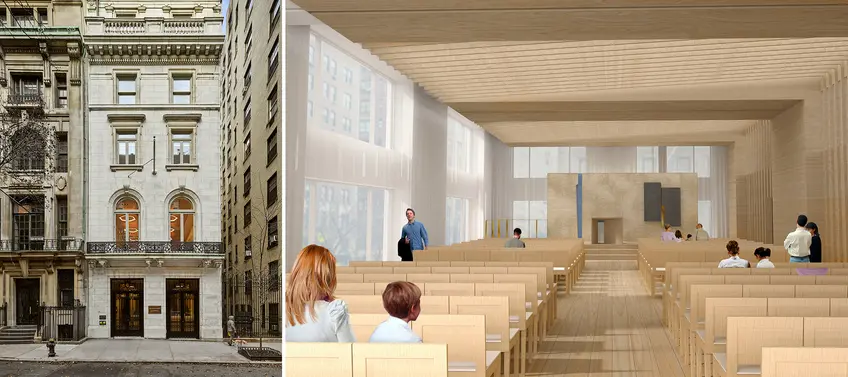 (l-r) Photograph of Park Avenue Synagogue via Frank Oudeman; all renderings via MBB Architects
(l-r) Photograph of Park Avenue Synagogue via Frank Oudeman; all renderings via MBB Architects
In a unique partnership, New York City architect Mary Burnham and Chicago Judaica artist and architect Amy Reichert, who happened to be close friends from college, worked together to renovate the Park Avenue Synagogue's Eli M. Black Lifelong Learning Center. The pair oversaw the gut-renovation of the historic townhome on Manhattan’s Upper East Side as a multipurpose education facility filled with flexible spaces to accommodate the needs of preschoolers to the elderly in a modern synagogue. CityRealty spoke to Reichert and Burnham to understand what designing a modern synagogue means, how they interpreted traditional Jewish values through design, and how they took design constraints and turned them into Jewish history storytelling gems.
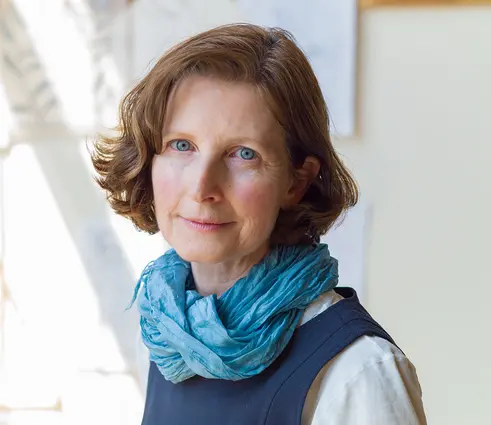 Amy Reichert headshot via Michelle Litvin
Amy Reichert headshot via Michelle Litvin
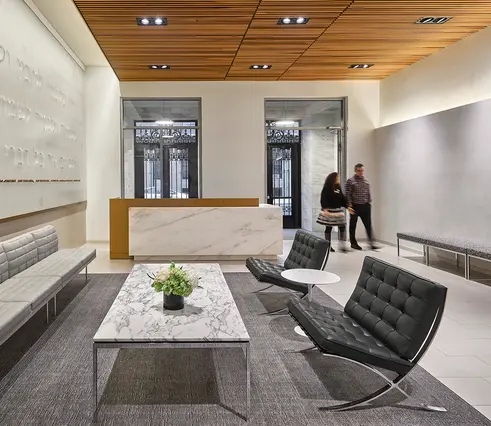 Entrance to Park Avenue Synagogue building
Entrance to Park Avenue Synagogue building
Amy Reichert is an award winning architect, exhibition designer, and designer of Judaica. Since 1996, when she won second place in the Philip and Sylvia Spertus Judaica Prize for her seder plate, she has participated in invited juried exhibitions in museums around the world. Her work can be seen on display at The Jewish Museum, NY, The Jewish Museum, Vienna, The Yale University Art Gallery, and The San Francisco Contemporary Jewish Museum. She received her B.A. and M.Arch from Yale University, and combines her studio work with teaching at the School of the Art Institute, Chicago.
How do you and Mary work together?
Mary and I are old friends from architecture graduate school. I am an architect in my regular practice here in Chicago but I do a lot of artwork. Mary is an architect but she is also a wonderful painter and has a very artistic approach to architecture. Mary is really sensitive to color, design and artistic side of architecture and although my role here is as an artist, I am always thinking: is this buildable? We come from these two sides but we meet in the middle---It has worked out really nicely.
Mary and I are old friends from architecture graduate school. I am an architect in my regular practice here in Chicago but I do a lot of artwork. Mary is an architect but she is also a wonderful painter and has a very artistic approach to architecture. Mary is really sensitive to color, design and artistic side of architecture and although my role here is as an artist, I am always thinking: is this buildable? We come from these two sides but we meet in the middle---It has worked out really nicely.
Tell me specifically about your work at the Eli M. Black Lifelong Learning Center.
It is a beautiful Beaux Artes townhouse that had been converted into a small school. The ceilings had been lowered, and they did what they had to do to make it work for them but it didn’t respect or celebrate the architecture of the building. We gutted the interior but we maintained the beautiful facade and floor plates. The second floor had gorgeous high ceilings since it was the original main living area of the house.
The building has a small footprint so we had to condense and make smart use of the square footage we had for this multi-purpose program. We needed space for a big lobby/waiting room, a chapel with an event space on the second floor, a lot of classrooms for multi-ages, and administrative offices as well. We had to pack a lot into six floors plus a rooftop, which we made into an event space and playground which overlooks Central Park and the Guggenheim.
It is a beautiful Beaux Artes townhouse that had been converted into a small school. The ceilings had been lowered, and they did what they had to do to make it work for them but it didn’t respect or celebrate the architecture of the building. We gutted the interior but we maintained the beautiful facade and floor plates. The second floor had gorgeous high ceilings since it was the original main living area of the house.
The building has a small footprint so we had to condense and make smart use of the square footage we had for this multi-purpose program. We needed space for a big lobby/waiting room, a chapel with an event space on the second floor, a lot of classrooms for multi-ages, and administrative offices as well. We had to pack a lot into six floors plus a rooftop, which we made into an event space and playground which overlooks Central Park and the Guggenheim.
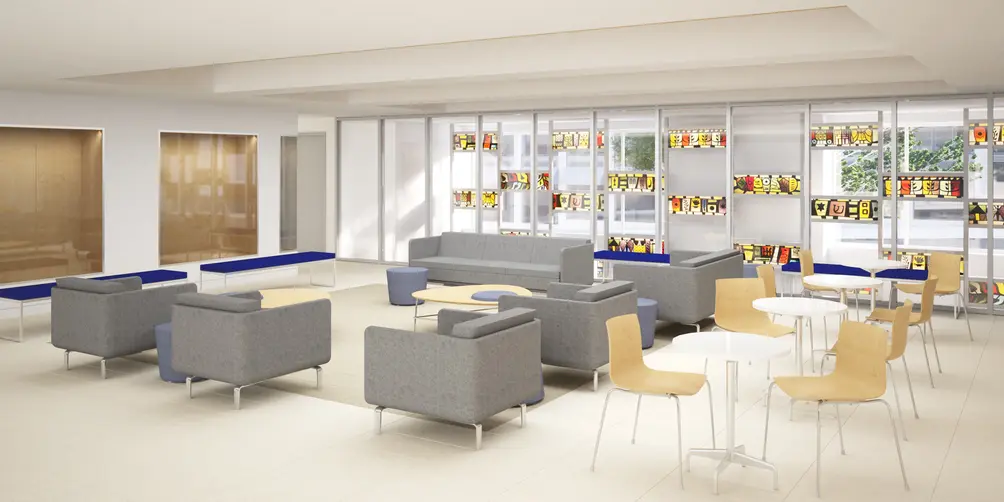 Lobby in Park Avenue Synagogue building
Lobby in Park Avenue Synagogue building
How did you translate traditional values into design decisions?
We both work in a very modern visual architectural language. Our challenge was to create a modern and airy space that really spoke to traditional values. That was the charge from the clergy who we worked really closely with, in addition to the education staff and board members. We worked together to collaborate on the message and functionality of each room in order to communicate Jewish values and not just make neutral spaces.
The lobby sets the tone. Not only is where you come in and are welcomed but many people wait in the lobby, for kids to finish religious school and activities. It is an important lingering space so rather than just have a neutral lobby, I worked with the rabbis to do create a wall mural with modern materials using phrases from a piece of Jewish liturgy. We carved into large resin panels which you can look through and see 12 values behind them, values like social justice, love, community, and things that have really beautiful resonance with their Hebrew counterparts.
We both work in a very modern visual architectural language. Our challenge was to create a modern and airy space that really spoke to traditional values. That was the charge from the clergy who we worked really closely with, in addition to the education staff and board members. We worked together to collaborate on the message and functionality of each room in order to communicate Jewish values and not just make neutral spaces.
The lobby sets the tone. Not only is where you come in and are welcomed but many people wait in the lobby, for kids to finish religious school and activities. It is an important lingering space so rather than just have a neutral lobby, I worked with the rabbis to do create a wall mural with modern materials using phrases from a piece of Jewish liturgy. We carved into large resin panels which you can look through and see 12 values behind them, values like social justice, love, community, and things that have really beautiful resonance with their Hebrew counterparts.
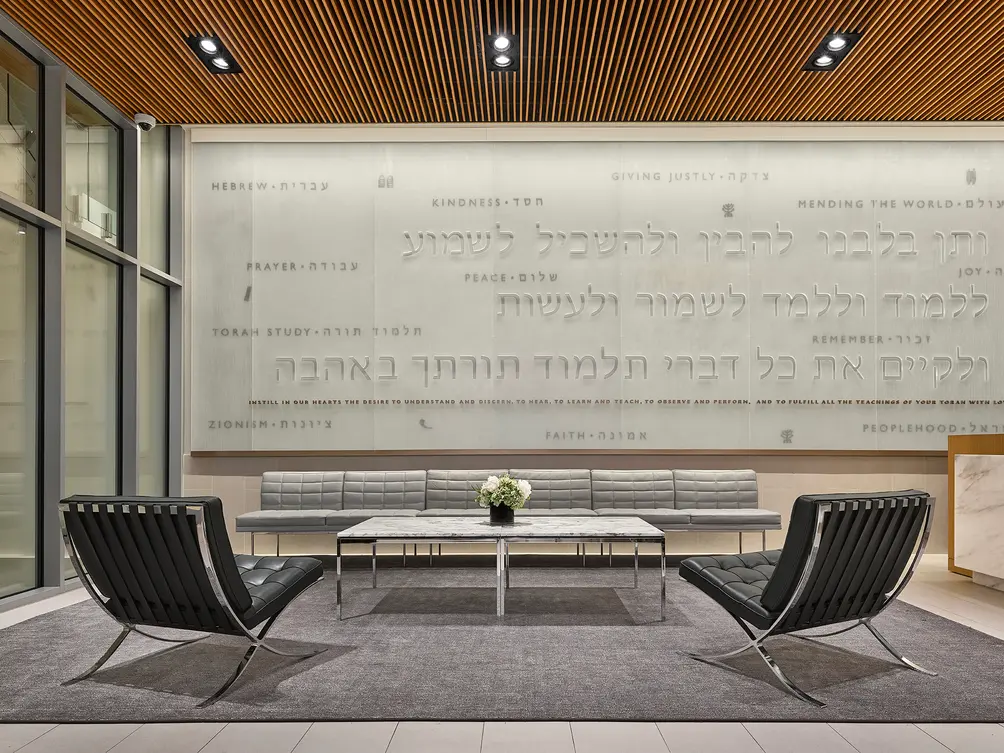 Bilingual artwork in Park Avenue Synagogue
Bilingual artwork in Park Avenue Synagogue
Another way we added value and content in every space was that the entire building is bilingual. This was a way to reinforce what students are learning and create a connection to the land of Israel. It was very important that the Hebrew language is highlighted. So all of the artwork and wayfinding signage has that dual language message.
Something I had enormous fun with but was also a huge amount of work was what we did with the halls. The building’s floors from the second floor to the sixth had these narrow hallways that function to circulate students to classrooms. Since we could not build them out we wanted to embed something in those hallways that resonated with the Jewish religion and history. The rabbi and I came up with the idea of taking all the events and dramatic stories from the Torah, which is the base text of Judaism calligraphed onto a long scroll When the Torah is unfurled, it is like a single huge text that goes from the beginning of creation through the death of Moses. But the Torah is all text ---so we thought, what if we took all those familiar events and matched them with a great work of art. So, for example, we took the teaching of let there be light, and Adam and Eve, and the pharaohs in Egypt. We took big and small stories that were all great works in the history of art from ancient mosaics, frescos from the year one to recent feminist artists from last year. It gives you this romp through the history of art.
Something I had enormous fun with but was also a huge amount of work was what we did with the halls. The building’s floors from the second floor to the sixth had these narrow hallways that function to circulate students to classrooms. Since we could not build them out we wanted to embed something in those hallways that resonated with the Jewish religion and history. The rabbi and I came up with the idea of taking all the events and dramatic stories from the Torah, which is the base text of Judaism calligraphed onto a long scroll When the Torah is unfurled, it is like a single huge text that goes from the beginning of creation through the death of Moses. But the Torah is all text ---so we thought, what if we took all those familiar events and matched them with a great work of art. So, for example, we took the teaching of let there be light, and Adam and Eve, and the pharaohs in Egypt. We took big and small stories that were all great works in the history of art from ancient mosaics, frescos from the year one to recent feminist artists from last year. It gives you this romp through the history of art.
We wanted great artwork. We didn’t want corny illustrations--- so you’ll see work from Rembrandt, Titian to Gerhard Richter. We addressed subjects like revelation or mourning or death both head-on, and tangentially, and we choreographed the friezes to make the stories come alive. I think it is the only one of its kind in the world. We had to do a lot of work to track down permissions for the high-resolution images for all the works. But it has become a major focus of the building. Kids run up and down the hallways and really notice the art. It is meant for anyone, from kids to adults, who want a fresh look at the traditional texts.
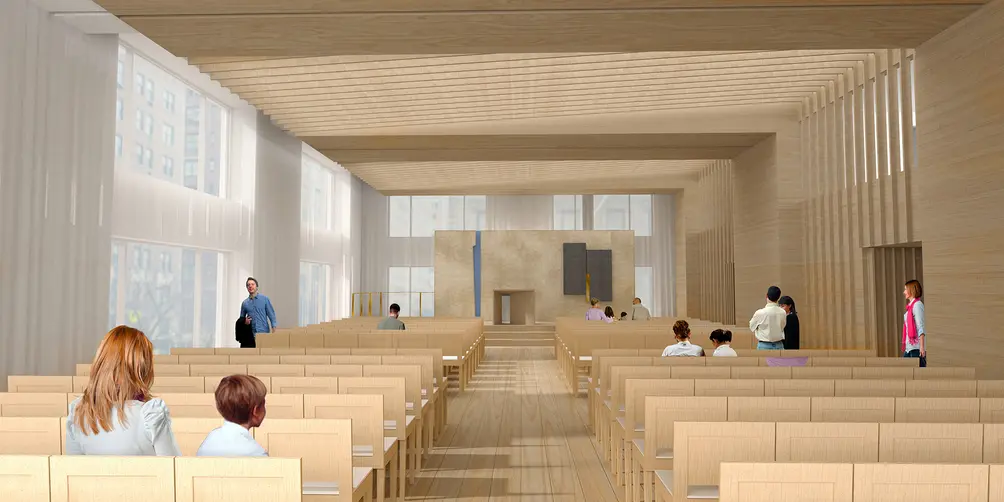 Chapel in Park Avenue Synagogue building
Chapel in Park Avenue Synagogue building
The chapel is a lovely space for religious services, but it also had to accommodate everything from lectures to cocktail parties. The chapel needed specific items like a table for reading Torah, a lectern, and an ark, which is a traditional cabinet to hold the Torah. But we also need those things to literally disappear when it was being used for another event. So, for instance, I custom designed the ark with Venetian plaster that has a little window which gives a hint of what is inside but it is not prominent. It has big doors and is a huge dramatic focus when it’s open but when the doors are closed, it is quiet and almost disappears.
There is a beautiful skylit stairwell which is the core of the building. There is glass on every floor so it is a place where people can meet and chat and we hoped, would encourage people to use the stairs versus the elevator.
There is a beautiful skylit stairwell which is the core of the building. There is glass on every floor so it is a place where people can meet and chat and we hoped, would encourage people to use the stairs versus the elevator.
This is the first building the synagogue built that is not attached to their beautiful, Moorish mothership on 87th and Madison Avenue. In the 1950s, an addition was built on that building with a beautiful glass facade but that 1950s building was eaten by a 1980s addition. We are in the process of gut renovating that 1980s building which removed the beautiful windows and glass facade from the 1950s building and reinstalled them haphazardly throughout the 1980s portion. They were single panel works of art that had been all glommed together. People really didn’t love or appreciate them in that way.
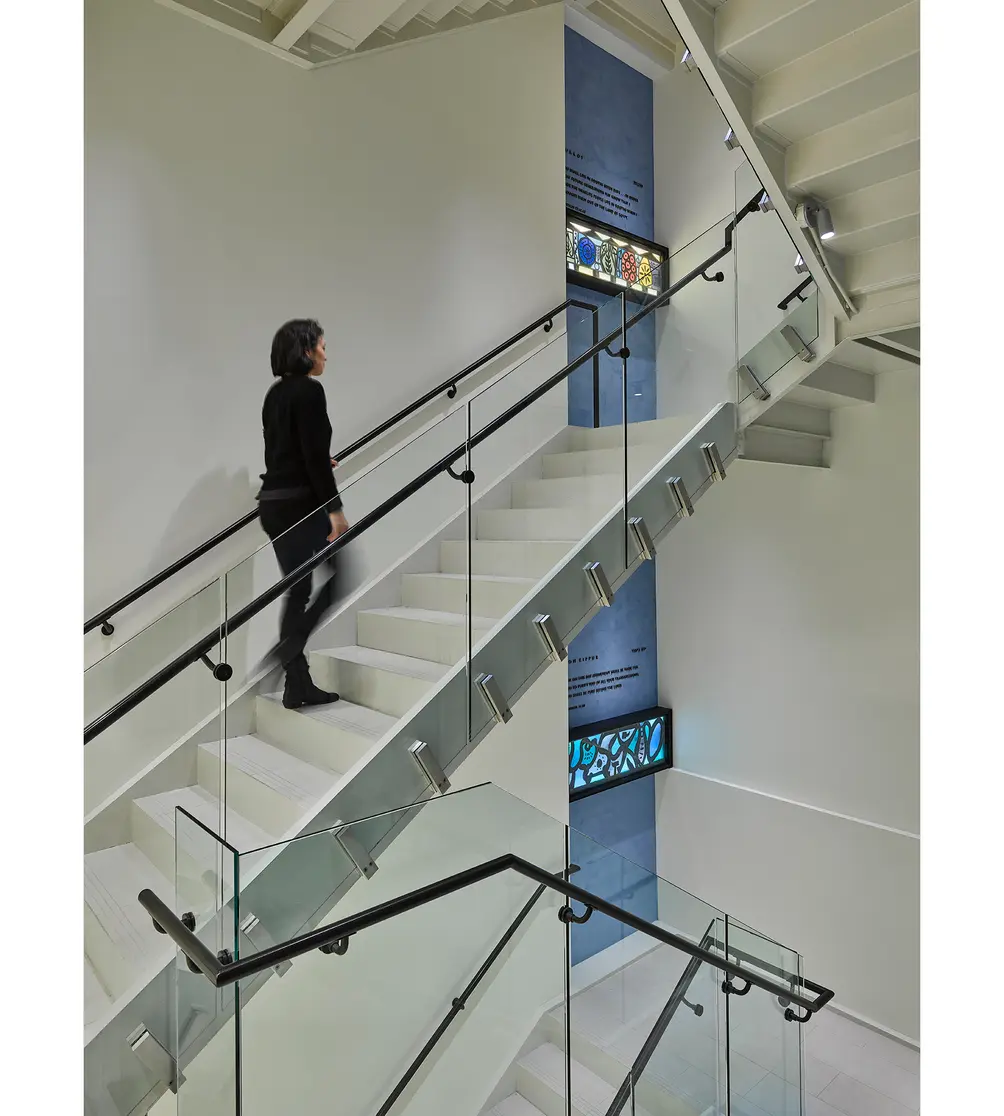 Stairwells and artwork in Park Avenue Synagogue
Stairwells and artwork in Park Avenue Synagogue
As a way to connect this building to the main complex, we wanted to find a way to use things that were undervalued and give them new life. These windows were prime for that. We knew they were beautiful and very important art from back in the day. We removed all of them (there were 80 total) and repurposed 10 of them in the stairwell. We backlit them with LED lightboxes. Each panel had a symbol and story and we now highlight the story with passages the clergy picked to go along with and explain them. Because we had 80 to work with, we picked 10 about the Jewish holiday cycle and put them in order from bottom to top. So now, as you walk up and down the stairway, you pass through Jewish annual holiday cycle and now people really get excited about them and understand them.
What is the best part of working with religious institutions?
Synagogues and churches have a lot of stuff. Our goal is to excavate and reinvigorate them. We found these gems and we want to resituate them so people would notice and appreciate them. It is really exciting for us to work for religious institutions because you know what you put out there will be there for a long time. And you know it will help the community. There is such richness of symbolism and tradition of ornament, and our mission is to extract those ideas and reframe for a modern, forward-looking congregation. We have a modern design with an eye to bringing life back to the past.
Synagogues and churches have a lot of stuff. Our goal is to excavate and reinvigorate them. We found these gems and we want to resituate them so people would notice and appreciate them. It is really exciting for us to work for religious institutions because you know what you put out there will be there for a long time. And you know it will help the community. There is such richness of symbolism and tradition of ornament, and our mission is to extract those ideas and reframe for a modern, forward-looking congregation. We have a modern design with an eye to bringing life back to the past.
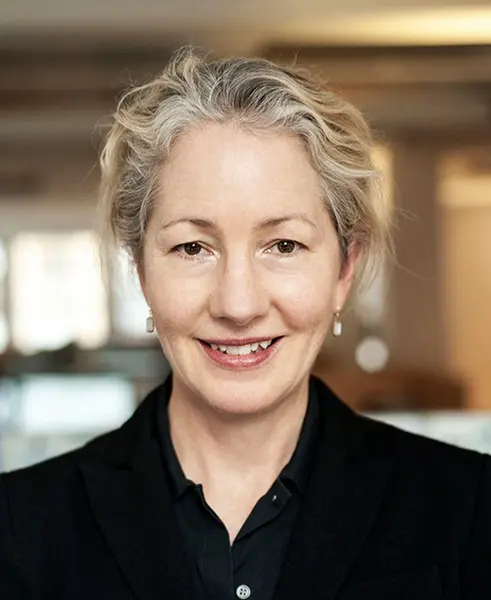 Mary Burnham headshot via MBB Architects
Mary Burnham headshot via MBB Architects
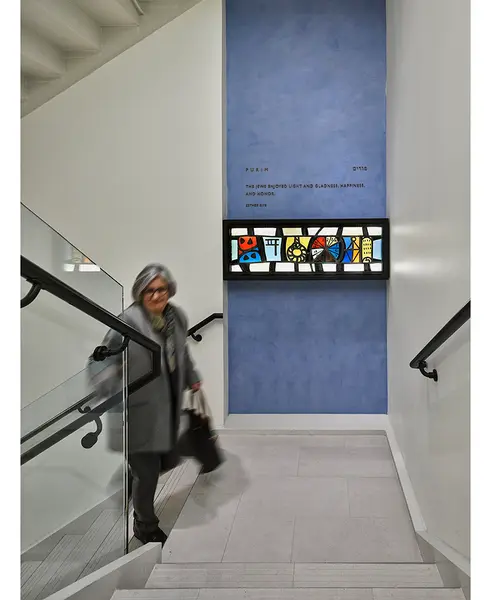 Stairwell details
Stairwell details
Mary Burnham's design sensibility and mastery of color and light are influenced, in part, by her experience as an accomplished painter. Ms. Burnham’s conviction is that design is an integrated endeavor where the lines of architecture, interior design, and landscape design blur and overlap. Along with receiving numerous design awards, many of Mary’s projects have been widely featured in design publications. Her work includes design of educational, cultural, residential, and commercial projects. In addition to her architectural work, she oversees the interior design division of the firm.
How did your work differ from Amy’s?
The Eli M. Black Lifelong Learning Center for Park Avenue Synagogue was our first collaboration but since then we have started working together on two additional projects, as we really admire each other’s work. While I am the lead architect, Amy’s pieces are more liturgical, such as designing the art pieces for the ark and the reading table. We worked jointly with Amy on the various liturgical aspects of the project, like the bimah--the platform where the religious rituals happen. My work focuses on how to make the architecture support the different types of services that are performed, and on the program and usage of the spaces that no longer conform to the more rigid and traditional services of the earlier times. Amy focused on the text and the application of the art theme, and we focused on how to integrate these textual art pieces into the architecture.
The Eli M. Black Lifelong Learning Center for Park Avenue Synagogue was our first collaboration but since then we have started working together on two additional projects, as we really admire each other’s work. While I am the lead architect, Amy’s pieces are more liturgical, such as designing the art pieces for the ark and the reading table. We worked jointly with Amy on the various liturgical aspects of the project, like the bimah--the platform where the religious rituals happen. My work focuses on how to make the architecture support the different types of services that are performed, and on the program and usage of the spaces that no longer conform to the more rigid and traditional services of the earlier times. Amy focused on the text and the application of the art theme, and we focused on how to integrate these textual art pieces into the architecture.
Our desire was to create a modern education building with a prayer space in it and to overlay art and displays that are fundamental to the mission of Park Avenue Synagogue. The key is to build that into the architecture from the beginning and not add on later. From the beginning, we conceived this project as a seamless integration of art and architecture, where the of the artwork is a result of an architectural process. That was key in this collaboration.
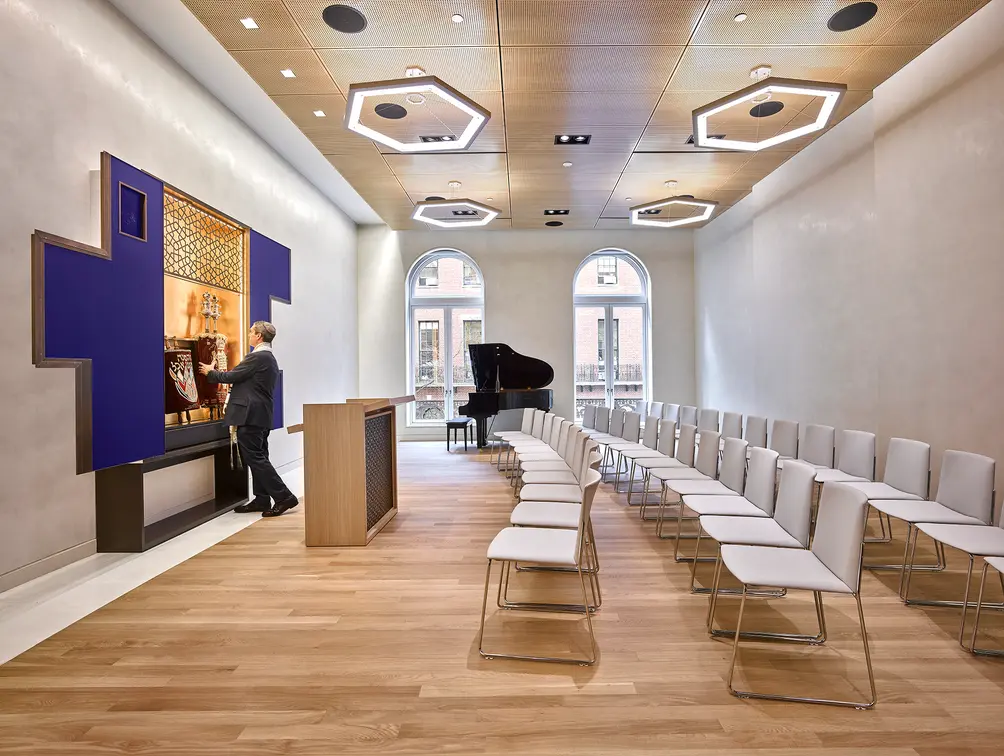 Flexible space in Park Avenue Synagogue
Flexible space in Park Avenue Synagogue
What does modern synagogue design mean?
Every religious institution has their own way of doing things but across the board, every institution we work with, whether they are Christian, Jewish or any religion, the trend is toward greater flexibility—with accessibility and creating spaces that have flexible use. We designed the spaces at the Eli M. Black Center so that fixtures are movable and can be set up in different ways. One space can have multiple uses like music performances, receptions, classes or different types of gatherings. The spaces are designed to also support non-religious uses.
When designing the room acoustics, we ensured there was a state of the art sound system so everyone can hear what is said, no matter where you are in the room. The acoustics not only amplify the spoken word but also accommodate musical performances.
Every religious institution has their own way of doing things but across the board, every institution we work with, whether they are Christian, Jewish or any religion, the trend is toward greater flexibility—with accessibility and creating spaces that have flexible use. We designed the spaces at the Eli M. Black Center so that fixtures are movable and can be set up in different ways. One space can have multiple uses like music performances, receptions, classes or different types of gatherings. The spaces are designed to also support non-religious uses.
When designing the room acoustics, we ensured there was a state of the art sound system so everyone can hear what is said, no matter where you are in the room. The acoustics not only amplify the spoken word but also accommodate musical performances.
Many, modern synagogues want the ability for the rabbi to have a closer relationship with their congregation. Typically, synagogues have elevated the rabbi and separated him at a distance from the congregation. There is a movement now to break down that barrier and have the rabbi closer to the people he’s communicating with. For example, thinking about how the bimah is designed to reinforce that connection led us to either remove the platform so everything on the same level, or lower the platform to one or two steps versus five. It’s about having a greater connection to the congregation.
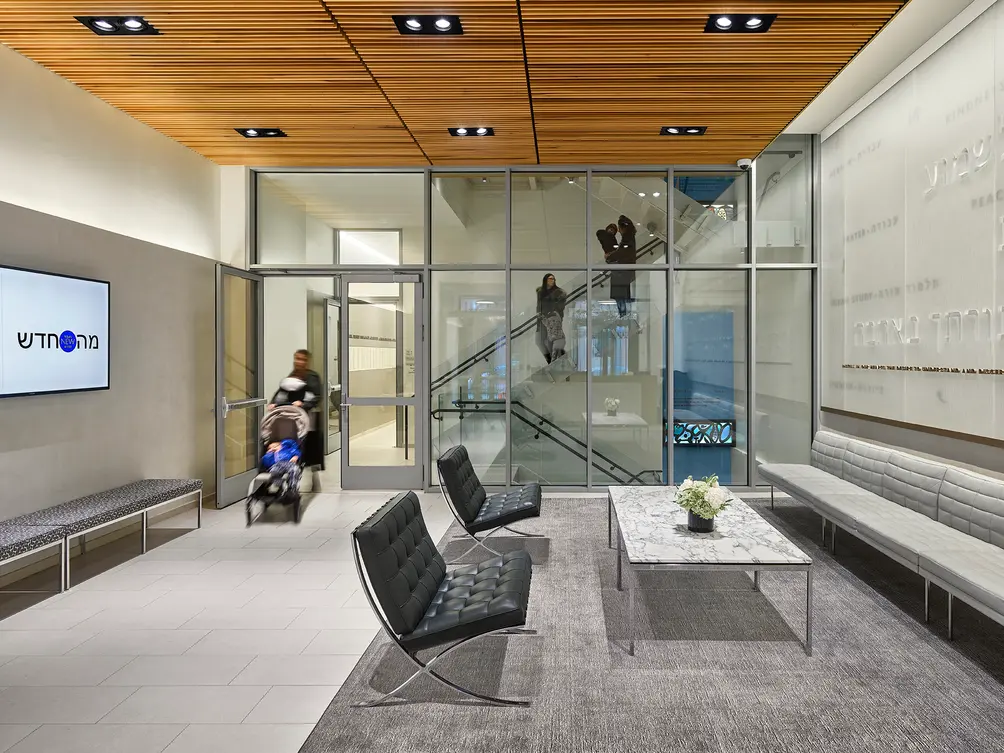 Connected areas in Park Avenue Synagogue
Connected areas in Park Avenue Synagogue
Supporting families is another important goal. All churches want to attract young audiences and young families. Many of these churches have services for children who like to sit on the floor. The Eli M. Black Center is an education building and was designed for everyone, from two-year-olds to their grandparents. There is a big elevator, bathrooms on every floor, a hearing loop in the chapel, and great acoustics to aid the hearing impaired.
We wanted an outdoor space on the roof for Sukkot but we also wanted a play space for the kids to run around. The center is mostly used in the morning by adults and the preschool population and, in afternoons, as an after-school Hebrew school for school-age kids. That roof play deck can be an outdoor classroom or a place to take a break.
We wanted an outdoor space on the roof for Sukkot but we also wanted a play space for the kids to run around. The center is mostly used in the morning by adults and the preschool population and, in afternoons, as an after-school Hebrew school for school-age kids. That roof play deck can be an outdoor classroom or a place to take a break.
Did you uncover anything surprising in the gut renovation?
We found that the foundation had issues and we needed to realign floor plates to make it accessible. Instead of walking in the building and immediately walking up a few steps, we pulled the ground floor down to ground level.
We found that the foundation had issues and we needed to realign floor plates to make it accessible. Instead of walking in the building and immediately walking up a few steps, we pulled the ground floor down to ground level.

Contributing Writer
Michelle Sinclair Colman
Michelle writes children's books and also writes articles about architecture, design and real estate. Those two passions came together in Michelle's first children's book, "Urban Babies Wear Black." Michelle has a Master's degree in Sociology from the University of Minnesota and a Master's degree in the Cities Program from the London School of Economics.

 6sqft delivers the latest on real estate, architecture, and design, straight from New York City.
6sqft delivers the latest on real estate, architecture, and design, straight from New York City.
